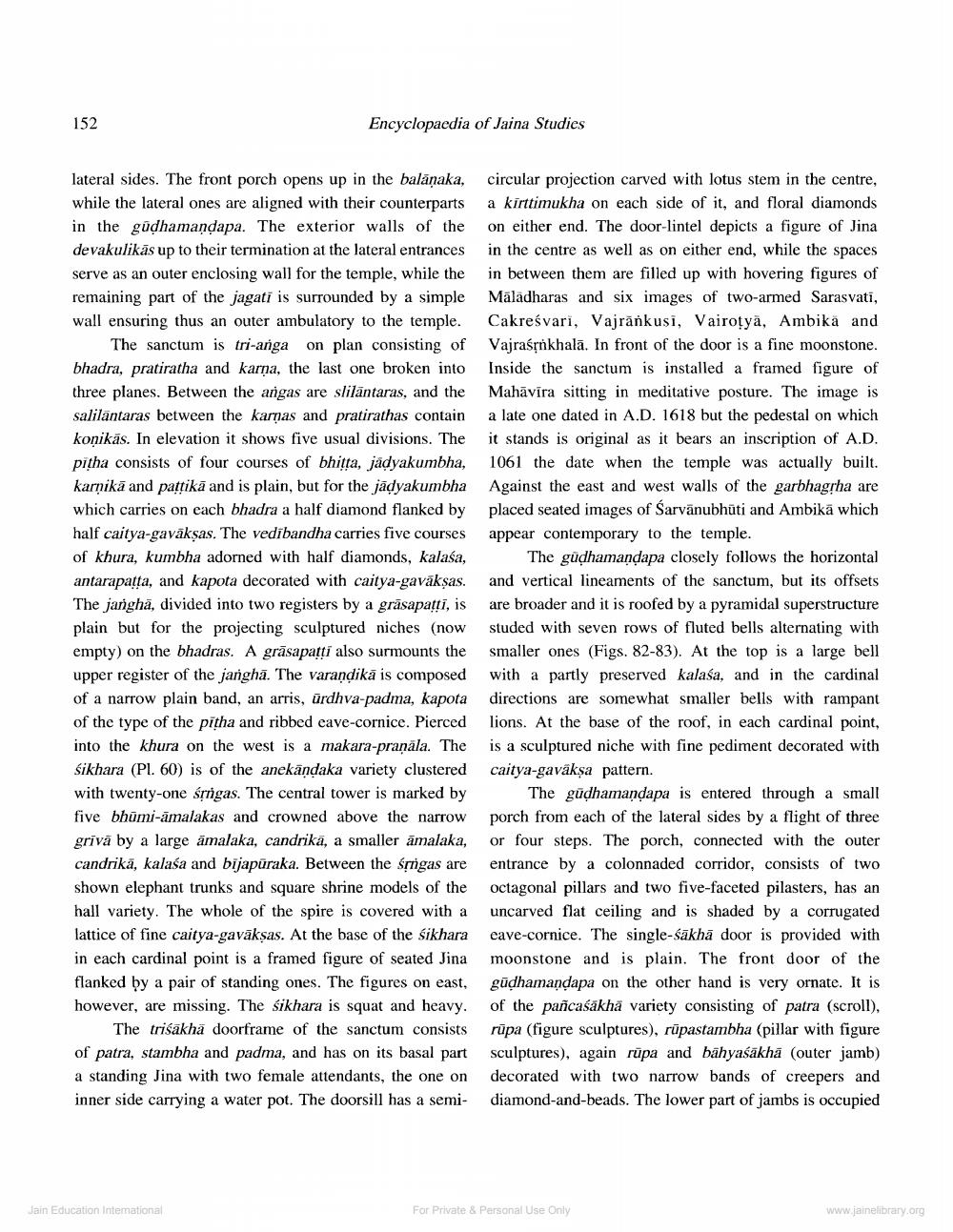________________
152
Encyclopaedia of Jaina Studies
lateral sides. The front porch opens up in the balāņaka, circular projection carved with lotus stem in the centre, while the lateral ones are aligned with their counterparts a kirttimukha on each side of it, and floral diamonds in the gūdhamandapa. The exterior walls of the on either end. The door-lintel depicts a figure of Jina devakulikās up to their termination at the lateral entrances in the centre as well as on either end, while the spaces serve as an outer enclosing wall for the temple, while the in between them are filled up with hovering figures of remaining part of the jagati is surrounded by a simple Maladharas and six images of two-armed Sarasvati, wall ensuring thus an outer ambulatory to the temple. Cakreśvari, Vajrānkusi, Vairoțyà, Ambika and
The sanctum is tri-anga on plan consisting of Vajraśțnkhalā. In front of the door is a fine moonstone. bhadra, pratiratha and karna, the last one broken into Inside the sanctum is installed a framed figure of three planes. Between the angas are slilāntaras, and the Mahāvīra sitting in meditative posture. The image is salilantaras between the karmas and pratirathas contain a late one dated in A.D. 1618 but the pedestal on which koņikās. In elevation it shows five usual divisions. The it stands is original as it bears an inscription of A.D. pitha consists of four courses of bhitta, jadyakumbha, 1061 the date when the temple was actually built. karnikā and pattikā and is plain, but for the jādyakumbha Against the east and west walls of the garbhagsha are which carries on each bhadra a half diamond flanked by placed seated images of Sarvānubhūti and Ambikā which half caitya-gavākşas. The vedibandha carries five courses appear contemporary to the temple. of khura, kumbha adorned with half diamonds, kalasa, The gudhamandapa closely follows the horizontal antarapatta, and kapota decorated with caitya-gavākşas. and vertical lineaments of the sanctum, but its offsets The janghā, divided into two registers by a grāsapatti, isare broader and it is roofed by a pyramidal superstructure plain but for the projecting sculptured niches (now studed with seven rows of fluted bells alternating with empty) on the bhadras. A grāsapatti also surmounts the smaller ones (Figs. 82-83). At the top is a large bell upper register of the jangha. The varandikā is composed with a partly preserved kalaša, and in the cardinal of a narrow plain band, an arris, urdhva-padma, kapota directions are somewhat smaller bells with rampant of the type of the pitha and ribbed eave-cornice. Pierced lions. At the base of the roof, in each cardinal point, into the khura on the west is a makara-pranala. The is a sculptured niche with fine pediment decorated with śikhara (Pl. 60) is of the anekāndaka variety clustered caitya-gavākṣa pattern. with twenty-one śmigas. The central tower is marked by The gūdhamandapa is entered through a small five bhūmi-āmalakas and crowned above the narrow porch from each of the lateral sides by a flight of three grīvā by a large amalaka, candrika, a smaller āmalaka, or four steps. The porch, connected with the outer candrikā, kalaśa and bijapūraka. Between the śmigas are entrance by a colonnaded corridor, consists of two shown elephant trunks and square shrine models of the octagonal pillars and two five-faceted pilasters, has an hall variety. The whole of the spire is covered with a uncarved flat ceiling and is shaded by a corrugated lattice of fine caitya-gavāksas. At the base of the sikhara cave-cornice. The single-sakhā door is provided with in each cardinal point is a framed figure of seated Jina moonstone and is plain. The front door of the flanked by a pair of standing ones. The figures on east. gūdhamandapa on the other hand is very ornate. It is however, are missing. The sikhara is squat and heavy. of the pañcaśakha variety consisting of patra (scroll),
The triśākhā doorframe of the sanctum consists rūpa (figure sculptures), rūpastambha (pillar with figure of patra, stambha and padma, and has on its basal part sculptures), again rūpa and bāhyaśākhā (outer jamb) a standing Jina with two female attendants, the one on decorated with two narrow bands of creepers and inner side carrying a water pot. The doorsill has a semi- diamond-and-beads. The lower part of jambs is occupied
Jain Education Intemational
For Private & Personal Use Only
For Private & Personal Use Only
www.jainelibrary.org




